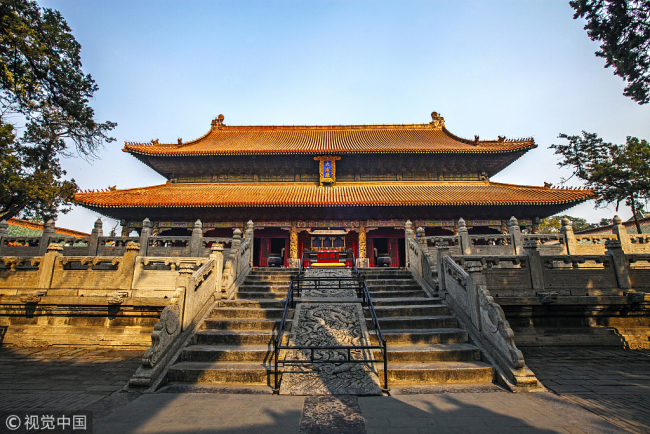Explore Shandong(3)—The hometown of Confucius

As a cornerstone of traditional Chinese culture, Confucianism has influenced China for thousands of years. Its founder, Confucius, is one of the most important characters in China's history, and one who has had an enduring and profound impact on the lives of Chinese people. In today's program, we will visit the hometown of Confucius as we take a culture tour around Shandong Province.
Located in the southwest part of Shandong province, the 5,000-year-old city of Qufu is the birthplace of Confucius. The stunning natural surroundings, with its gorgeous lake, lush mountains, and vast farm lands were the home and inspiration of the world-renowned philosopher and educator.
Qufu served as the capital of the State of Lu during the Spring and Autumn Period (770-476 B.C). In the city, you'll find many historic palaces, temples, and cemeteries. Many of the cultural sites are associated with Confucius, which makes it a great place to learn about Confucian culture.
The Confucius Temple in the center of Qufu City is one of the major local landmarks. The temple was built to commemorate the philosopher in 478 B.C., a year after his death.
The residence-turned temple has undergone continual cycles of renovation and expansion as emperors from successive dynasties competed in their veneration of this great sage. It was not until during the reign of the Qing Dynasty Emperor Yongzheng (1723-1735) that the temple took on its current appearance. It now has more than 460 halls, altars, towers, and pavilions, 54 archways, and 13 steles bearing the calligraphy by various emperors.
Covering an area of 22 hectares, the temple is one of the greatest complexes of ancient building in the country. It is one of the three largest ancient architectural complexes in China, together with the Forbidden City in Beijing and the Chengde Mountain Resort.
Inside of the temple complex, there is a large statue of Confucius, along with many other historic and cultural items related to his life. In autumn, thousands of people from all over the world visit the site to attend a solemn memorial ceremony, a truly unforgettable event.
East of the Confucian Temple is the Confucius Family Mansion, which was the historic residence of the philosopher's descendants.
The residence was owned by the eldest male descendants of Confucius, who were granted special privileges by China's emperors. Covering a total area of 16 hectares, the mansion is composed of three parts, with 9 courtyards, and 463 halls, towers, and verandas. The first four yards contain work area, and the other five serve as residences.
After being renovated and expanded many times, it turned into a typical mansion of a Chinese feudal noble, the largest of its kind in China. It boasts luxury furnishings, exquisite decorations, and a large collection of historic of documents along with precious cultural relics.
Located in the north of the city, the Cemetery of Confucius is the world's largest family cemetery, and it has a history that stretches back more than two thousand years.
The tomb of Confucius is the most eye-catching sight here. But alongside his tomb there are the graves of most of his descendants and clansmen, including his son Kong Li and grandson Kong Ji. There are more than 100 thousand tombs spread across the 200 hectare site.
Spotted around the cemetery are more than 100 thousand trees of different species, lending it the appearance of a botanical garden.
And if you have an interest in Chinese calligraphy, you can find various steles, large stones that have carvings of calligraphy written by some of China's most famous calligraphers.
The three sites, the Temple, the Family Mansion, and the Cemetery, are collectively known as the San Kong, "the Three Confucian Iconic Sites". Together they were recognized by UNESCO as a World Heritage Site in 1994.
Apart from the ancient historical sites, the Confucius Six Arts City is a modern memorial to Confucius in Qufu. It is a large cultural tourism site based on "the Six Arts" of traditional rites, music, archery, chariot driving, calligraphy, and mathematics, all of which Confucius taught and advocated. The 200,000 square meter educational park showcases the life and works of Confucius by combining modern high-tech interactive displays along side traditional style architecture and decoration.
It also provides visitors with opportunities to experience ceremonial rituals, play classic Chinese drums, carry a sedan chair, and take part in folk performances, which all provide visitors with insights into Confucian culture.
Before we end our culture journey in Shandong's Qufu city, I should take the opportunity to mention some of the other things that make Shandong Province a great place for history buffs to visit. It's a birthplace of some of China's traditional handicrafts like porcelain and kite making. And it's the hometown of figures including the great philosopher Mencius, the "Sage of military Strategy" Sun-tzu, the "Sage of Calligraphy" Wang Xizhi, the builder and inventor Lu Ban, and the Song Dynasty poet Li Qingzhao. These are just some of the reasons why Shandong Province has been a major contributor to China's long, rich cultural and artistic history.

